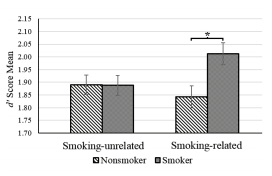The aim of this study is to determine the effects of an experimentally induced negative mood on cigarette smokers’ cravings and attentional bias toward smoking-related visual stimuli using the Visual Dot Probe Task (VDPT). Forty smoker and 40 nonsmoker male participants (18-30 years old) were randomly assigned into negative mood and neutral/control conditions. Before the mood induction manipulation (MIM), participants’ emotional state was measured with the Mood-State Adjective Pairs List (MSAPL) as pre-test scores. The MIM was then applied by presenting instrumental music and International Affective Picture System (IAPS) photos with negative valences at the same time for 3 min 22 sec. The control group, however, received only neutral IAPS photos without any music for the same duration in negative MIM. Afterwards, all groups were subjected to VDPT, then the MSAPL was reapplied for obtaining the post-test scores. Next, to determine the change in smokers’ willingness to smoke, the Smoking Craving Scale (SCS) was applied, and for their dependence levels, the Fagerström Test for Nicotine Dependence (FTND). Lastly, positive mood induction was applied only to participants exposed to the negative MIM for ethical concerns. Measurements, d' prime scores based on signal detection theory, and reaction times related to the correct responses for VDPT were analyzed using the 2(Group: Smoker, Nonsmoker) x 2(Mood State: Negative, Neutral) x 2(Relationship: Smoking-related, Smoking-unrelated) mixed ANOVA. The SCS indicates an increase in the desire for smoking to exist after exposure to the smoking-related stimuli. Comparison of the pre- and post-MSAPL scores reveals the negative MIM to be successful. According to the VDPT analyses, smokers reacted more accurately and quickly to smoking-related pictures than nonsmoking-related ones. Thus, smokers are more likely to process smoking-related stimuli faster and to show an attentional bias toward them. No such finding exists for nonsmokers. Smoking-related stimuli create an attentional bias for smokers, reflecting a change in their cognitive processes. Though negative mood boosts that bias, being exposed to smoking-related stimuli is more effective on smoking desire and, thus, on craving than negative mood.
To cite this article: Kalınkılıç, E., & Baran, Z. (2019). The effects of negative mood manipulation on the attentional bias of smoking and nonsmoking young adult males. Addicta: The Turkish Journal on Addictions, 6, 567–610. http://dx.doi.org/10.15805/addicta.2019.6.3.0047

.jpg)

.png)

